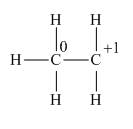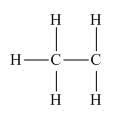
Concept explainers
Assign formal charges to each carbon atom in the given species. All lone pairs have been drawn in.
a.
 d.
d. 
(a)
Interpretation: The formal charge on each carbon atom in the given species is to be assigned.
Concept introduction: The formal charge on an atom is calculated by the formula,
Answer to Problem 1.39P
In the given species, the formal charge on carbon atom of
Explanation of Solution
The given species is
The formal charge on an atom is calculated by the formula,
Substitute these values in the above equation to calculate the formal charge.
For the carbon present in
Substitute these values in above equation to calculate the formal charge on the carbon of
Thus, in the given species, the formal charge on carbon atom of
(a) In the given species, the formal charge on carbon atom of
(b)
Interpretation: The formal charge on each carbon atom in the given species is to be assigned.
Concept introduction: The formal charge on an atom is calculated by the formula,
Answer to Problem 1.39P
In the given species, the formal charge on carbon atom is zero as shown below.
Explanation of Solution
The given species is
The formal charge on an atom is calculated by the formula,
Substitute these values in above equation to calculate the formal charge on carbon atom.
Thus, in the given species, the formal charge on carbon atom is zero.
In the given species, the formal charge on carbon atom is zero.
(c)
Interpretation: The formal charge on each carbon atom in the given species is to be assigned.
Concept introduction: The formal charge on an atom is calculated by the formula,
Answer to Problem 1.39P
In the given species, the formal charge on carbon atom is zero as shown below.

Explanation of Solution
The given species is,

Figure 1
The formal charge on an atom is calculated by the formula,
For the given carbon atom,
Substitute these values in above equation, to calculate the formal charge on carbon atom.
Thus, in the given species, the formal charge on carbon atom is zero.

Figure 2
In the given species, the formal charge on carbon atom is zero.
(d)
Interpretation: The formal charge on each carbon atom in the given species is to be assigned.
Concept introduction: The formal charge on an atom is calculated by the formula,
Answer to Problem 1.39P
In the given species, the formal charge on carbon atom of

Explanation of Solution
The given species is,

Figure 3
The formal charge on an atom is calculated by the formula,
Substitute these value in above equation to calculate the formal charge on the carbon of
For the carbon of
Substitute these value in above equation to calculate the formal charge on the carbon of
Thus, in the given species, the formal charge on carbon atom of

Figure 4
In the given species, the formal charge on carbon atom of
Want to see more full solutions like this?
Chapter 1 Solutions
Package: Loose Leaf for Organic Chemistry with Biological Topics with Connect Access Card
Additional Science Textbook Solutions
Applications and Investigations in Earth Science (9th Edition)
Biology: Life on Earth with Physiology (11th Edition)
Human Biology: Concepts and Current Issues (8th Edition)
Brock Biology of Microorganisms (15th Edition)
General, Organic, and Biological Chemistry - 4th edition
- What is the final product when D-galactose reacts with hydroxylamine?arrow_forwardIndicate the formula of the product obtained by reacting methyl 5-chloro-5-oxopentanoate with 1 mole of 4-penten-1-ylmagnesium bromide.arrow_forwardIn the two chair conformations of glucose, the most stable is the one with all the OH groups in the equatorial position. Is this correct?arrow_forward
- please help me with my homeworkarrow_forwardhelparrow_forwardThe temperature on a sample of pure X held at 1.25 atm and -54. °C is increased until the sample boils. The temperature is then held constant and the pressure is decreased by 0.42 atm. On the phase diagram below draw a path that shows this set of changes. pressure (atm) 2 0 0 200 400 temperature (K) Xarrow_forward
- QUESTION: Answer Question 5: 'Calculating standard error of regression' STEP 1 by filling in all the empty green boxes *The values are all provided in the photo attached*arrow_forwardpressure (atm) 3 The pressure on a sample of pure X held at 47. °C and 0.88 atm is increased until the sample condenses. The pressure is then held constant and the temperature is decreased by 82. °C. On the phase diagram below draw a path that shows this set of changes. 0 0 200 temperature (K) 400 аarrow_forwarder your payment details | bar xb Home | bartleby x + aleksogi/x/isl.exe/1o u-lgNskr7j8P3jH-1Qs_pBanHhviTCeeBZbufuBYT0Hz7m7D3ZcW81NC1d8Kzb4srFik1OUFhKMUXzhGpw7k1 O States of Matter Sketching a described thermodynamic change on a phase diagram 0/5 The pressure on a sample of pure X held at 47. °C and 0.88 atm is increased until the sample condenses. The pressure is then held constant and the temperature is decreased by 82. °C. On the phase diagram below draw a path that shows this set of changes. pressure (atm) 1 3- 0- 0 200 Explanation Check temperature (K) 400 X Q Search L G 2025 McGraw Hill LLC. All Rights Reserved Terms of Use Privacy Cearrow_forward
 Chemistry: The Molecular ScienceChemistryISBN:9781285199047Author:John W. Moore, Conrad L. StanitskiPublisher:Cengage Learning
Chemistry: The Molecular ScienceChemistryISBN:9781285199047Author:John W. Moore, Conrad L. StanitskiPublisher:Cengage Learning Chemistry: Principles and PracticeChemistryISBN:9780534420123Author:Daniel L. Reger, Scott R. Goode, David W. Ball, Edward MercerPublisher:Cengage Learning
Chemistry: Principles and PracticeChemistryISBN:9780534420123Author:Daniel L. Reger, Scott R. Goode, David W. Ball, Edward MercerPublisher:Cengage Learning

